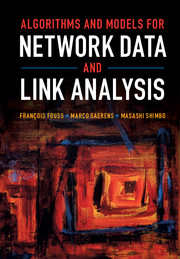Book contents
- Frontmatter
- Contents
- List of Algorithms
- List of Symbols and Notation
- Preface
- 1 Preliminaries and Notation
- 2 Similarity/Proximity Measures between Nodes
- 3 Families of Dissimilarity between Nodes
- 4 Centrality Measures on Nodes and Edges
- 5 Identifying Prestigious Nodes
- 6 Labeling Nodes: Within-Network Classification
- 7 Clustering Nodes
- 8 Finding Dense Regions
- 9 Bipartite Graph Analysis
- 10 Graph Embedding
- Bibliography
- Index
10 - Graph Embedding
Published online by Cambridge University Press: 05 July 2016
- Frontmatter
- Contents
- List of Algorithms
- List of Symbols and Notation
- Preface
- 1 Preliminaries and Notation
- 2 Similarity/Proximity Measures between Nodes
- 3 Families of Dissimilarity between Nodes
- 4 Centrality Measures on Nodes and Edges
- 5 Identifying Prestigious Nodes
- 6 Labeling Nodes: Within-Network Classification
- 7 Clustering Nodes
- 8 Finding Dense Regions
- 9 Bipartite Graph Analysis
- 10 Graph Embedding
- Bibliography
- Index
Summary
Introduction
The general purpose of graph embedding is to associate a position or vector in a Euclidean space – usually of low dimensionality – to each node of the graph G. The Euclidean space in which the nodes are represented as points is called the embedding space. The points themselves are called and defined by node vectors {xi}ni=1 and their coordinates are gathered in a data matrix X. This mapping thus corresponds to a configuration of the nodes in a Euclidean space preserving the structure of the graph as much as possible. For instance, a useful property of such a mapping would be that the neighbors of each node in G are also neighbors of the same nodes in the embedding space, according to the Euclidean distance in this space, and vice versa, that the neighbors of each node in the embedding space are also neighbors in the graph [512]. When the embedding space has dimension two or three, this technique is also called graph drawing and provides a layout of the graph that can be drawn.
Consider for instance the example of a social network defined by its adjacency matrix. It would be nice to have a three-dimensional drawing of this network in which we can navigate. This reduces to the computation of a configuration of the nodes in the three-dimensional Euclidean space preserving the structure of the graph together with some aesthetic properties [17] (for a sample of nice ways to draw a graph, see, e.g., [533]).
There is a vast literature on graph embedding and drawing. This chapter only presents a few methods, starting with some spectral methods which define the embedding according to eigenvectors of graph-related matrices. According to [473, 474], these techniques have two distinctive advantages:
▸ They provide a sound formulation minimizing a well-defined criterion, which almost always leads to an exact closed-form solution to the embedding problem.
▸ The solutions can be computed exactly, even for relatively large graphs while in other formulations (e.g., spring models or other physical models), the solution can usually only be approximated.
- Type
- Chapter
- Information
- Algorithms and Models for Network Data and Link Analysis , pp. 437 - 478Publisher: Cambridge University PressPrint publication year: 2016



